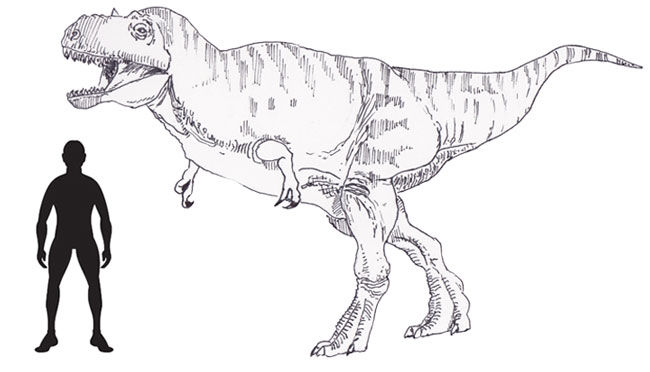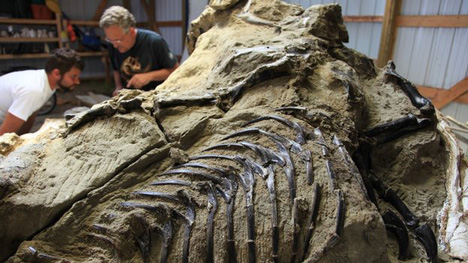Auction Date Set for “Battling Dinosaurs”
The auction date has been set for the sale of a remarkable fossil, one that shows a tyrannosaur fighting with a horned dinosaur, both specimens could make a significant contribution to the study of vertebrate mega fauna of Late Cretaceous Montana. The meat-eater, fossils of which are so beautifully preserved, almost the entire skeleton has remained in situ, could resolve the puzzle as to whether a ferocious, “pocket battleship of a tyrannosaur” actually existed. These specimens will go under the hammer at Bonhams Auction House (New York), on November 19th. If you are looking for an unusual Christmas present expect to pay somewhere between $7 million and $9 million USD (£4.41 – £5.67 million GBP), experts predict that this auction lot will fetch a world record price for a fossil sale.
“Duelling Dinosaurs”
Many palaeontologists and academics are concerned that if these extremely rare specimens end up in private hands then the fossils may not be made available for scientific research. The “Montana Duelling Dinosaurs”, a record of dinosaur inter-specific combat preserved for 67 million years may be lost to science. The horned dinosaur is believed to be a type of chasmosaurine ceratopsian, belonging to the same group of horned dinosaurs as the famous Triceratops. The tyrannosaur, estimated at around seven metres in length could be a specimen of a Nanotyrannus (N. lancensis). A skull discovered in 1942 and initially ascribed to the Gorgosaurus genus was later discovered to represent an adult animal not a juvenile. In 1988, in the light of a study suggesting that this relatively diminutive skull did, indeed, represent a fully grown individual, the genus Nanotyrannus was erected.
Picture credit: Everything Dinosaur
To view models and replicas of tyrannosaurs and other dinosaurs: PNSO Age of Dinosaurs.
“Little Tyrant”
Nanotyrannus means “little tyrant”. Whether Nanotyrannus is a separate genus, or whether the fossils ascribed to Nanotyrannus actually represent juvenile specimens of already described tyrannosaurs has been hotly debated by palaeontologists. The discovery of such a complete fossil tyrannosaur could resolve this debate.
To read more about the discovery of these fossils: Duelling Dinosaurs Up For Auction.
Pete Larson of the Black Hills Institute, (South Dakota), himself a highly respected expert on tyrannosaurids, has been involved in the preparation work. His PhD supervisor Dr Phil Manning (Manchester University) has been granted access to the “duelling dinosaurs” and this week he will present his preliminary findings at a British Science Festival to be held in Newcastle.
The Fossil Specimen – “Duelling Dinosaurs”
Dr Manning commented:
“This is possibly the most astoundingly amazing fossil in the world. Even if it were a T. rex, it would be a big find because the fossil is 99.9 per cent complete. The most valuable T. rex ever found was only eighty-five percent complete.”
Comparing Forearms
Recalling his observations of the fossil material, Dr Manning stated that tyrannosaurs were famous for having small forearms, but the forearm of the Montana specimen was much larger in proportion when compared to an adult tyrannosaurus rex. Unless the arms did not grow as fast as the rest of the animal as it matured, then the disproportionately large arms could indicate that Nanotyrannus is a real and distinct genus.
Dr Manning was able to identify a number of important anatomical characteristics that could help confirm the existence of a mid-sized, intermediate predator amongst the Late Cretaceous dinosaur mega fauna of Montana. The tyrannosaur, whose teeth are embedded amongst the cervical vertebrae of the chasmosaur, is described as a graceful looking creature with a flexible but strong neck. Although, much more time to study the two fossils is required, Dr Manning did suggest that:
“This find indicates that T. rex faced a mid-sized competitor predator or that they preyed on Nanotyrannus.”
Studying the Hell Creek Formation
For many years, scientists have pondered over the structure of the food chain when vertebrate fossils from the Hell Creek Formation are considered. Whether scavenger or hunter, Tyrannosaurus rex is regarded as the apex predator, but little evidence had been found that suggested mid-sized predators in this ecosystem. The only other predatory dinosaurs known from the Hell Creek Formation are the very much smaller dromaeosaurids, dinosaurs such as Saurornitholestes and Dromaeosaurus, which measure little more than two metres in length.
Phil Manning concluded:
“It seems logical that this animal filled an intermediate ecological niche between the vast T. rex and contemporary dromaeosaur predators.”
However, the fate of this specimen and whether or not it will be able to studied in greater detail depends on the swing of an auctioneer’s gavel.
We at Everything Dinosaur hope that if a museum or some other academic institution is unable to raise the funds required to purchase the fossil, the buyer will permit full scientific access to this important discovery.







Leave A Comment